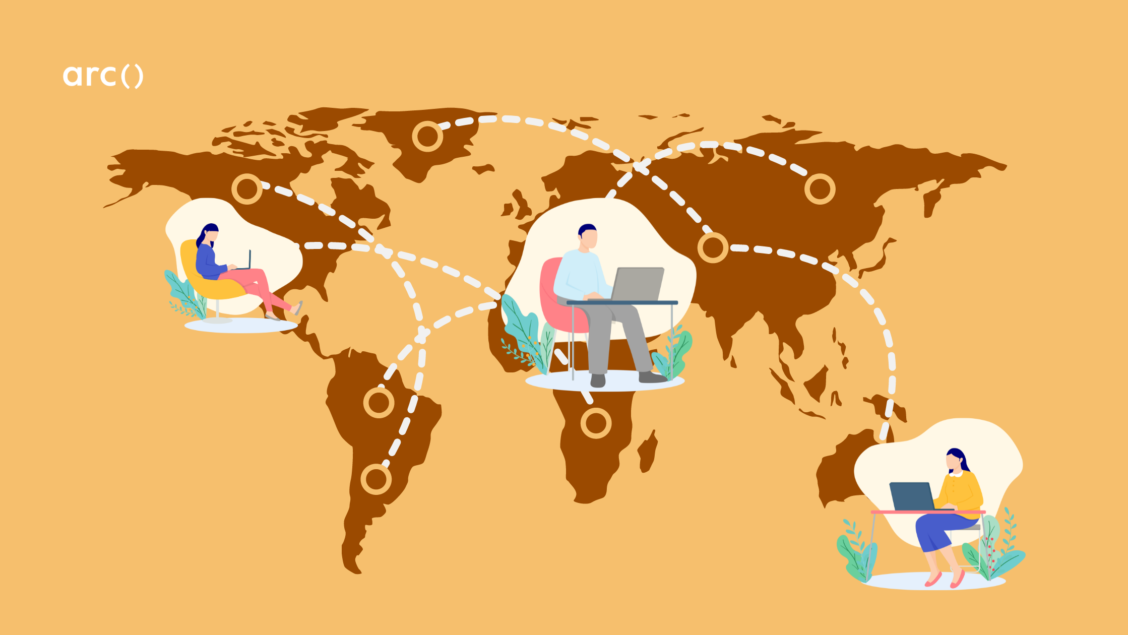Are you looking to save costs and gain access to top talent for your software projects? Offshore software development might be your answer. In 2022, the global outsourcing market was valued at $620 billion and is expected to reach nearly $905 billion by 2027. This growth reflects a trend where businesses worldwide are leveraging offshore software development teams to tap into specialized skills, cut expenses, and accelerate project timelines.
But what exactly is offshore software development, and how can it benefit your business? Let’s take a look into the world of offshore software development projects and see how this strategy can give you a competitive edge.
Looking for top talent fast? See how Arc can help you:
⚡️ Find developers, designers, marketers, and more
⚡️ Freelance or full-time remote + fully vetted
⚡️ Save up to 80% with global hires
Hire top talent with Arc risk-free →
What is Offshore Software Development?
When businesses consider software development options, they often encounter three main models: offshore, onshore, and nearshore development. Each model has its own advantages and is defined by the geographical distance between the client and the software development project or team. Understanding these distinctions can help businesses choose the right approach based on their specific needs, whether it’s proximity, cost, or access to a particular skill set.
- Offshore Development: Offshore development involves outsourcing software projects to a team located in a distant country, often on a different continent and in a different time zone. This model is typically chosen for cost-effectiveness, as labor costs in offshore locations are usually lower than in the client’s home country. However, it can present challenges like communication barriers, cultural differences, and time zone misalignment, which may affect project timelines and collaboration.
- Onshore Development: Onshore development refers to hiring a software development team within the same country or region as the client. This model ensures easy communication, shared time zones, and similar cultural practices, which can lead to smoother collaboration. Onshore development is often preferred when a project requires close coordination, real-time collaboration or when the client prioritizes working with local talent. However, it tends to be more expensive due to higher local labor costs.
- Nearshore Development: Nearshore development strikes a balance between the two by outsourcing to neighboring countries or regions that are relatively close in terms of distance and time zones. This approach offers a mix of cost savings and easier communication compared to offshore development, while still benefiting from some of the proximity advantages of onshore development. Nearshore development is often chosen when businesses seek a middle ground, leveraging cost efficiencies while minimizing the challenges associated with distance and cultural differences.
Offshore software development allows companies to tap into a global talent pool and use the expertise of skilled software developers from worldwide. By outsourcing to offshore locations, companies can access high-quality software development services at lower costs compared to hiring locally. This cost advantage of offshore software outsourcing often arises from the lower labor costs and operational expenses in offshore locations.
Benefits of Offshore Software Development
Offshore software development offers several compelling advantages for businesses seeking to optimize their operations and gain a competitive edge:
1. Cost Savings: Using talent from countries with lower labor costs reduces overall and development costs and expenses while maintaining high-quality standards, allowing businesses to allocate more resources to other critical areas.
2. Access to Global Talent: Offshore development enables companies to tap into a diverse and highly skilled workforce from around the world. This ensures that businesses can find the right professionals with the specific expertise required for their projects, regardless of geographical limitations.
3. Flexibility and Scalability: Companies can easily scale their offshore development teams up or down based on project requirements without the constraints of traditional in-house hiring processes. This agility allows businesses that hire offshore developers to quickly adapt to changing market conditions, fluctuating workloads, or evolving project scopes. Additionally, offshore teams can provide round-the-clock support, enabling continuous development and faster time-to-market.
4. Focus on Core Competencies: By outsourcing software development tasks, companies can concentrate more on their core competencies and strategic objectives. This focus can lead to increased efficiency, productivity, and overall business success.
Challenges of Offshore Software Development
Despite the numerous benefits of software offshore outsourcing, the offshore outsourcing of software development also presents challenges that businesses must navigate:
1. Communication Barriers: Working with teams across different countries and time zones can lead to language differences and communication styles, causing misunderstandings and delays. Clear and effective communication is crucial for ensuring project requirements are understood, tasks are assigned correctly, and progress is reported accurately.
2. Time Zone Differences: Limited or no overlap in working hours between the client and the software offshore development team can make real-time collaboration and meetings difficult. This can slow down the development process and hinder effective communication and decision-making.
3. Quality Control: Ensuring that the offshore team adheres to the same coding standards, testing protocols, and quality metrics as the the onshore software development team is essential for maintaining consistency and meeting quality expectations.
4. Cultural Differences: Different work cultures, communication styles, and approaches to problem-solving can lead to misunderstandings and conflicts. It is crucial to foster an environment of mutual respect and understanding and establish clear guidelines for addressing cultural differences proactively.
Best Practices for Successful Offshore Software Development
To maximize the benefits of offshore software development and mitigate potential risks, follow these best practices:
1. Effective Communication: Establish clear communication channels and protocols from the outset. Regular video calls, daily standups, and collaborative tools like Slack or Microsoft Teams can help bridge the physical distance and ensure everyone is on the same page.
2. Clear Expectations and Goals: Both the client and the full offshore development services team should have a shared understanding of the project requirements, timelines, deliverables, and success criteria. Detailed documentation and regular check-ins can help achieve this alignment.
3. Progress Monitoring: Implement agile methodologies, such as Scrum or Kanban, to provide transparency into the development process and facilitate frequent feedback loops. Regular demos, retrospectives, and sprint reviews can ensure the project progresses as planned and allows for timely course corrections.
4. Building Strong Relationships: Fostering a sense of partnership and trust in house team and with the offshore team can lead to better collaboration, increased productivity, and higher-quality outcomes. Cultural awareness, respect for differences, and a willingness to learn from each other can strengthen these relationships.
You can also try Arc, your shortcut to the world’s best remote talent:
⚡️ Access 450,000 top developers, designers, and marketers
⚡️ Vetted and ready to interview
⚡️ Freelance or full-time
Try Arc and hire top talent now →
Choosing the Right Offshore Software Development Partner
Selecting the right offshore software development company to partner is crucial for the success of offshore custom software development for your project. Here are some key factors to consider:
1. Expertise and Experience: Look for a partner with proven expertise in your industry or the specific technologies required for your project. Evaluate their portfolio, case studies, and client testimonials to gauge their experience and capabilities.
2. Communication and Cultural Fit: Effective communication is essential in an offshore development team for companies or freelancers. Consider partners with strong English proficiency and a compatible work culture. Assess their communication processes, responsiveness, and ability to bridge cultural gaps.
3. Quality Assurance and Processes: Inquire about the company’s quality assurance practices, development methodologies, and project management processes. Ensure they have robust systems to deliver high-quality work and meet deadlines.
4. Team Structure and Availability: Understand the team structure and availability of resources dedicated to your project. Ensure they can scale up or down as needed and provide continuous support throughout the project lifecycle.
When evaluating potential partners, ask questions such as:
- What is your experience in our industry or with similar projects?
- How do you ensure effective communication and collaboration with clients?
- What quality assurance processes do you have in place?
- How do you handle project management and timeline adherence?
- Can you provide references or case studies from previous clients?
Top Offshore Software Regions
When considering offshore software development, choosing the right region is crucial. Each area offers distinct advantages and challenges, from cost-effectiveness to time zone compatibility. Below, we outline the pros and cons of offshoring in Eastern Europe, Asia, and South America to help you make an informed decision.
Eastern Europe
Poland, Ukraine, and Romania are among the top countries to offshore developer talent. Here are the pros and cons of offshoring in Eastern Europe.
Pros:
- A large pool of highly skilled and educated developers
- Close cultural similarities with Western countries
- Relatively low labor costs compared to Western Europe and North America
- Convenient time zones for collaboration with companies in Europe and the US
Cons:
- Language barriers can sometimes be an issue, especially with older developers
- Potential political instability in certain regions
- Competition for top talent can be fierce
Learn more: Ukraine, Poland, Estonia, Romania: Where to Build Your Engineering Team
Asia
India, the Philippines, and Vietnam are leading destinations for offshoring developers. Here are the pros and cons of hiring offshore talent in Asia.
Pros:
- Vast talent pool with a strong focus on STEM education
- Highly cost-effective labor rates
- Round-the-clock software development team and capabilities due to time zone differences
- Rapidly improving infrastructure and technological advancements
Cons:
- Significant cultural and language barriers
- Concerns over intellectual property protection in some countries
- Managing remote teams across large geographic distances can be challenging
South America
Brazil, Argentina, and Mexico are prime locations for sourcing software developer talent in South America. Here are the pros and cons of offshoring software developers in Latin America.
Pros:
- Rapidly growing tech hubs, especially in countries like Brazil and Argentina
- Relatively low labor costs compared to North America and Western Europe
- Convenient time zones for collaboration with companies in the Americas
- Experienced senior-level developers
- Cultural similarities with Western countries
Cons:
- Potential political and economic instability in some regions
- Infrastructure and connectivity issues in some countries
Learn more: Canada, Mexico, and Argentina: Where to Build Your Engineering Hub
Each region offers unique advantages and challenges for offshore software development companies. The choice ultimately depends on the specific needs, budget, and priorities of your own software outsourcing company. Carefully evaluate and due diligence are essential when selecting an offshore software development location.
Cost of Hiring Offshore Software Developers
The cost of offshore software development can vary significantly depending on several factors:
1. Location: Countries with lower living costs and competitive labor markets offer more cost-effective rates for software development services. For example, the average hourly rate for a software developer in India can range from $25 to $50, while in the United States, the rate can be $100 or higher.

2. Project Complexity: More complex projects with intricate requirements, advanced technologies, and extensive integration typically cost more than simpler projects.
3. Team Size: The larger the offshore team, the higher the overall cost. However, larger teams can often complete projects faster, potentially offsetting some additional expenses.
4. Project Duration: Longer projects may incur additional costs for ongoing management, communication, and infrastructure maintenance.
5. Developer Experience: Highly skilled and experienced developers with specialized expertise will command higher rates than entry-level or junior developers.
6. Infrastructure and Tools: The cost of required software licenses, development tools, and infrastructure (e.g., cloud services) can add to the overall cost of a software project.
7. Project Management: Effective project management is crucial for offshore development success, and the costs associated with project managers, quality assurance, and communication tools should be factored in.
8. Hidden Costs: Potential hidden costs may include:
- Travel expenses for on-site meetings or team coordination
- Language translation or interpretation services
- Additional training or knowledge transfer costs
- Costs associated with cultural differences or misunderstandings
- Potential intellectual property protection expenses
Accurately estimating the cost of offshore software development involves thoroughly evaluating the project requirements, team composition, and additional services or resources needed. Request detailed cost breakdowns from potential offshore software developers and partners to understand the cost components and make informed decisions.
You can also try Arc, your shortcut to the world’s best remote talent:
⚡️ Access 450,000 top developers, designers, and marketers
⚡️ Vetted and ready to interview
⚡️ Freelance or full-time
Try Arc and hire top talent now →
When to Use Offshore Software Development
Offshore, software and mobile app development companies can be a strategic choice for businesses in different scenarios:
1. Scaling Development Capacity: Offshore teams provide additional capacity when in-house teams are overwhelmed with projects or when there is a need to ramp up development resources quickly.
2. Accessing Specialized Skills: Offshore development provides access to specific technical skills or expertise that may be scarce or expensive in the local market.
3. Cost Optimization: Offshore development helps reduce overall project costs, especially for companies based in regions with high labor costs.
4. Focusing on Core Competencies: By outsourcing non-core activities like they outsource software development and web development too, businesses can redirect their resources and attention to their core competencies and strategic initiatives.
5. Round-the-Clock Development: Offshore teams in different time zones provide continuous progress and faster time-to-market, beneficial for projects with tight deadlines or requiring 24/7 support and maintenance.
Why Choose Arc for Offshore Software Development Services?
Arc is a leading global marketplace offshore software development center connecting companies with top remote software development talent from around the world.
Arc offers a seamless and efficient solution for businesses seeking to leverage offshore software development benefits.
Overview of Arc’s Services
Arc provides a comprehensive suite of services to streamline the hiring process:
- HireAI: An AI-powered talent matching instantly matches ensures the best-fit developers for project requirements, saving valuable time and resources.
- Talent Vetting: Developers on Arc’s platform undergo rigorous vetting, including technical assessments, background checks, and interviews, to ensure the highest-qualified professionals.
- Flexible Engagement Models: Arc offers flexible engagement models to suit specific needs, whether for a single freelancer or an entire dedicated team.
Benefits of Using Arc’s HireAI
Arc’s HireAI revolutionizes the whole offshore software development outsourcing space by streamlining the talent acquisition process. Key benefits include:
- Speed: Instantly identify the best-fit developers with auto-matching, significantly reducing your time-to-hire.
- Accuracy: AI algorithms analyze the technical skills, experience, and cultural fit of the project manager, ensuring alignment with project requirements.
- Cost-effectiveness: By eliminating traditional recruitment methods and manual screening, HireAI saves on hiring fees and streamlines the development process, resulting in significant cost savings.
Testimonials and Success Stories
Over 800 fast-growing companies and startups have benefited from partnering with Arc for their offshore software development services. Below, we highlight the experiences of two of our valued clients, Baxus and Prodapt, who successfully scaled their offshore software development teams, with Arc’s help.
Baxus
The Challenges Baxus Faced
Baxus, a growing blockchain startup, needed to quickly hire skilled developers within budget. U.S. hires were too expensive, and they needed talent in different time zones to manage shifts effectively.
How Arc Helped Baxus
Arc provided Baxus with pre-vetted global developers, matching them with top candidates who met their technical and cultural needs. This allowed Baxus to hire an affordable, skilled Full Stack Developer from Colombia, reducing costs and enhancing their team’s diversity.

Prodapt
The Challenges Prodapt Faced
Prodapt needed to quickly hire a developer in LATAM to support their growing client base. However, with limited connections and recruitment experience in the region, finding the right talent was a challenge.
How Arc Helped Prodapt
Arc provided Prodapt with a curated list of pre-vetted remote developers in LATAM, tailored to their technical needs and time zone preferences. This streamlined the hiring process, ensuring Prodapt found the right developer quickly and efficiently.

Conclusion
Offshore software development offers strategic advantages for businesses seeking to optimize their software development processes, reduce costs, and access a global talent pool. Companies that practices offshore software development can streamline operations and stay competitive by leveraging cost savings, scalability, and access to specialized skills.
Navigating offshore development challenges, such as communication barriers, time zone differences, and cultural nuances, requires implementing best practices like effective communication strategies, clear goal-setting, and regular progress monitoring.
When selecting an offshore software development partner, prioritize factors like expertise, experience, and reputation to ensure seamless collaboration and high-quality deliverables.
Arc emerges as a trusted partner for your offshore software development team, offering a global marketplace of top remote talent, vetted and ready to interview. With Arc’s HireAI, you can hire freelance or full-time offshore developers, in hours, ensuring access to the best talent quickly and efficiently.
Use Arc’s HireAI to find and hire top remote developers instantly, accessing the full potential of offshore software development for your business.
Looking for top talent fast? See how Arc can help you:
⚡️ Find developers, designers, marketers, and more
⚡️ Freelance or full-time remote + fully vetted
⚡️ Save up to 80% with global hires








